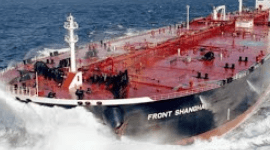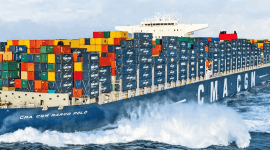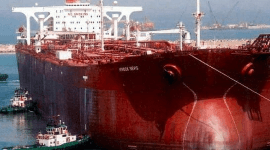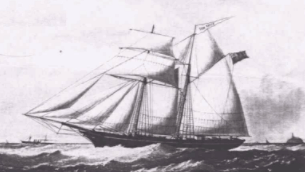Duddon Shipbuilding Company
The Amlwch shipowner and builder William Thomas had been involved with the Duddon shipping trade since its earliest days. Eventually he was persuaded to open a shipyard there, in partnership with William Postlethwaite. This subsidiary of the Amlwch yard was also known as William Thomas & Co., and was started at Borwick Rails in 1870. At the head of the twelve man workforce was Hugh Jones, a foreman-shipwright from Amlwch. Work started on their first vessel, a 113 ton schooner ordered by the Duddon Shipping Association, almost as soon as the yard was ready in the following year. This first vessel was the Nellie Bywater (photo below), built to Special Survey and launched in December 1873. Like all other schooners built at this yard, she was strongly built for the iron ore trade, and this strength was to enable her to work a long career. Her full story has been told by her final owner, Capt. Richard England. One of the very last schooner captains, he was in command when she foundered off Plymouth in December 1951 with the loss of two lives.

The Millom shipyard must have been primarily involved in repair work. Its second schooner, the Countess of Lonsdale, was built as a speculation and took over four years to build. Launched in 1878, she was managed for her first few years by William Postlethwaite before eventually William Thomas became her owner . For the next few years the shipyard concentrated on building steamers. Three were built, all for the Lady Kate Steamship Co., principally owned by Thomas Massicks, proprietor of the Millom Ironworks. The subsequent launch of the three-masted schooner Greyhound in 1886 marked the end of William Thomas & Co. at Duddon. The ownership of the yard passed to Hugh Jones and his brother, Micaiah, and it became known as the Duddon Shipbuilding Company.

The Millom shipyard must have been primarily involved in repair work. Its second schooner, the Countess of Lonsdale, was built as a speculation and took over four years to build. Launched in 1878, she was managed for her first few years by William Postlethwaite before eventually William Thomas became her owner . For the next few years the shipyard concentrated on building steamers. Three were built, all for the Lady Kate Steamship Co., principally owned by Thomas Massicks, proprietor of the Millom Ironworks. The subsequent launch of the three-masted schooner Greyhound in 1886 marked the end of William Thomas & Co. at Duddon. The ownership of the yard passed to Hugh Jones and his brother, Micaiah, and it became known as the Duddon Shipbuilding Company.
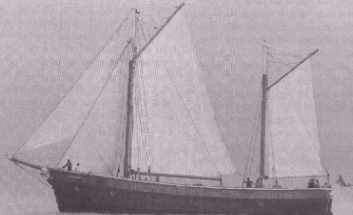
The first two ships from the yard under its new ownership were both schooners built for the Duddon Shipping Association. They were the Florence Petherick, launched in 1893, and the Happy Harry, launched the following year. The latter ship was a three-master named after Mr. Harry Arnold, a generally cheerful director of the Hodbarrow Mining Company. She was to have a long life, the last years of which were spent at Arklow in company with the Ashburner three-masters.
By this time wooden shipbuilding had already ceased at Barrow and Ulverston, and was in decline elsewhere. To keep his workforce in employment, Hugh Jones built the Becca and Mary as a speculation. She was the yard's finest vessel, a 162 ton barquentine, built largely of teak and to Special Survey, with a Lloyd's classification of 14 years A1. After her launch in 1904 she was managed by Jones himself for nine years, before eventually being sold to Portuguese owners. She survived until 1953 when she foundered off the coast of Newfoundland.
The last vessel built by the Duddon Shipbuilding Company, and the last schooner built in England, was the Emily Barratt (photo above). Ordered by the Hodbarrow Mining Co. in 1910, she was launched on Easter Monday, 1913. She traded for the iron company until 1922, was then sold and continued to trade until 1960, interrupted in the War by a spell as an anchorage for a barrage ballon. She was broken-up at the Dock Museum, Barrow in 1999.
